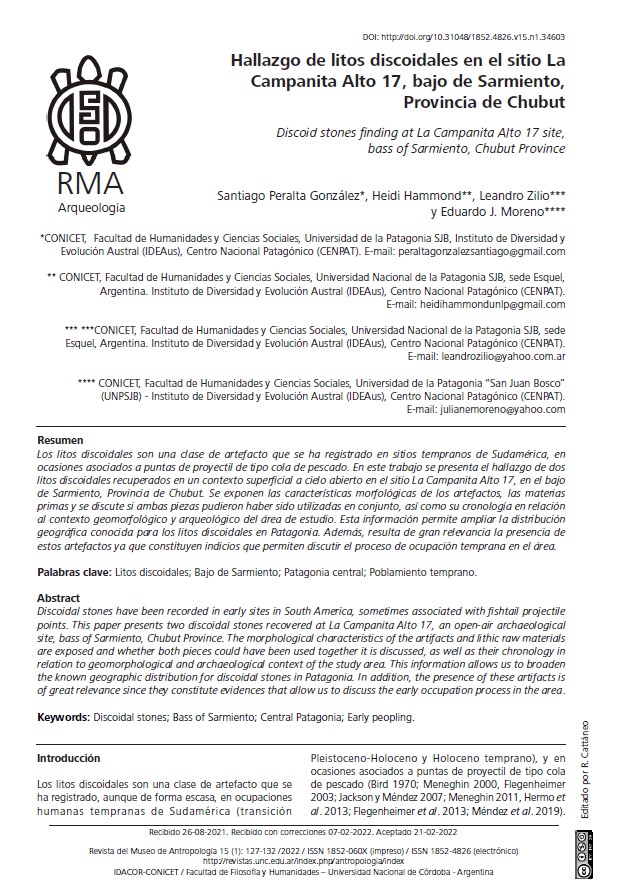Discoid stones finding at La Campanita Alto 17 site, bass of Sarmiento, Chubut Province
DOI:
https://doi.org/10.31048/1852.4826.v15.n1.34603Keywords:
Discoidal stones, Bass of Sarmiento, Central Patagonia, Early peoplingAbstract
Discoidal stones have been recorded in early sites in South America, sometimes associated with fishtail projectile points. This paper presents two discoidal stones recovered at La Campanita Alto 17, an open-air archaeological site, bass of Sarmiento, Chubut Province. The morphological characteristics of the artifacts and lithic raw materials are exposed and whether both pieces could have been used together it is discussed, as well as their chronology in relation to geomorphological and archaeological context of the study area. This information allows us to broaden the known geographic distribution for discoidal stones in Patagonia. In addition, the presence of these artifacts is of great relevance since they constitute evidences that allow us to discuss the early occupation process in the area.
Downloads
References
Bird, J. (1970). Paleo-indian discoidal stones from southern South America. American Antiquity, 35 (2), 205-209.
Bird, J. (1993). Viajes y arqueología en Chile Austral, editado por J. Hyslop. Ediciones de la Universidad de Magallanes, Punta Arenas.
Cardich, A., L. Cardich y A. Hajduk. (1973). Secuencia arqueológica y cronología radiocarbónica de la Cueva 3 de Los Toldos (Santa Cruz, Argentina). Relaciones de la Sociedad Argentina de Antropología, VII, 85-114.
Casal, G. A., Allard J.O. y Foix, N. (2015). Análisis estratigráfico y paleontológico del Cretácico Superior en la Cuenca del Golfo San Jorge: nueva unidad litoestratigráfica para el Grupo Chubut. Revista de la Asociación Geológica Argentina, 72, 77-95.
Castro, JC. y Terranova, E (2015). Indicadores paleoindios en la provincia de Entre Ríos (Argentina). Comechingonia, 19 (1), 183-190.
Césari, O. y Simeoni, A. (1994). Planicies fluvioglaciares terrazadas y bajos eólicos de la Patagonia Central, Argentina. 13º Symposium Latin-American Geosciences, Zentralblatt fur Geologie und Palaontologie, 1, 1993, 1/2, 155-164.
Coronato, F. (2003). El problema de la desecación del lago Colhué Huapi desde la Geografía Histórica. Contribuciones científicas GAEA, 15, 165-170.
Flegenheimer, N. (2003). Cerro El Sombrero: A locality with a view. En L. Miotti, M. Salemme y N. Flegenheimer (Eds.), Where the South Winds Blow: Ancient Evidence of Paleo South Americans, (pp. 51-56). Texas: Center for the Study of the First Americans, Texas A&M University.
Flegenheimer, N., C. Bayón y A. Pupio (2006). Llegar a un nuevo mundo. La arqueología de los primeros pobladores del actual territorio argentino. Museo y Archivo Histórico Municipal, Bahía Blanca.
Flegenheimer, N., N. Mazzia y M.P. Babot. (2013). Estudios de detalle sobre una piedra discoidal pampeana. Intersecciones en Antropología, 14, 499-505.
González Días, E. F. y Di Tommaso. (2014). Paleogeoformas lacustres en los lagos Musters y Colhué Huapí, su relación genética con un paleolago Sarmiento previo, centro sur del Chubut. Revista de la Asociación Geológica Argentina, 71 (3), 416-426.
Hermo, D., E. Terranova, L. Marchionni, L. Magnin, B. Mosquera y L. Miotti. (2013). Piedras o litos discoidales en Norpatagonia: evidencias en la Meseta de Somuncurá (Río Negro, Argentina). Intersecciones en Antropología, 14, 507-511.
Jackson, D. y C. Méndez (2007). Litos discoidales tempranos en contextos paleoindios de Sudamérica. Magallania, 35 (1), 75-84.
Méndez, C., Nuevo Delaunay, A., Reyes, O., Maldonado, A., y García, J. L. (2019). A systematic strategy for assessing the early surface archaeological record of continental Aisén, Central Western Patagonia. En Suárez, R. y Ardelean, C. (Eds.), People and Culture in Ice Age Americas, New Dimensions in Paleoamerican Archaeology, Capítulo 3 (pp. 34-51). Salt Lake City: University of Utah Press.
Meneghin, U. (2000). Primer registro de un artefacto discoidal (?) paleoindio del Uruguay. Comunicaciones Antropológicas del Museo de Historia Natural de Montevideo 2 (19): 1-12.
Meneghin, U. (2011). Observaciones sobre algunos artefactos líticos discoidales registrados en el Uruguay. Orígenes, 10, 1-32.
Montes, A., Rodríguez, S.S., San Martín C.N. y Allard, J.O. (2015). Migración de campos de dunas en cañadones costeros de Patagonia. Geomorfología e implicaciones paleoclimáticas. Revista de la Sociedad Geológica de España, 28(2), 65-76.
Montes, A., Rodríguez, S. S. y Domínguez, C. E. (2017). Geomorphology context and characterization of dunefields developed by the southern westerlies at drying Colhué Huapi shallow lake, Patagonia Argentina. Aeolian Research, 28, 58-70.
Moreno, E. J., H. Pérez Ruiz, y F. Ramírez Rozzi. (2016). Esquema cronológico y evolución del paisaje en el bajo de Sarmiento (Chubut). En F. Mena (Ed.), De mar a mar (pp. 477-485). Santiago de Chile: Ediciones CIEP/ Ñire Negro.
Moreno, E. J., S. Peralta González, A. Svoboda. (2021). Aproximación a la cronología de la pesca en el bajo de Sarmiento (Chubut, Argentina) a partir de la distribución de pesos líticos. Arqueología 27(2), 91-107.
Sciutto, A. (2008). Hoja Geológica Escalante (4569-IV), Provincia del Chubut, SEGEMAR. Carta Geológica de la República Argentina, escala 1:250.000.

Downloads
Published
Issue
Section
License
Copyright (c) 2022 Santiago Peralta Gonzalez, Heidi Hammond, Leandro Zilio, Eduardo Moreno

This work is licensed under a Creative Commons Attribution-NonCommercial-ShareAlike 4.0 International License.
Those authors who have publications with this Journalaccept the following terms:
a. Authors will retain their copyrights and guarantee the journal the right of first publication of their work, which will be simultaneously subject to the Creative Commons Attribution License (Licencia de reconocimiento de Creative Commons) that allows third parties to share the work as long as its author and his first publication in this journal.
b. Authors may adopt other non-exclusive licensing agreements for the distribution of the version of the published work (eg, deposit it in an institutional electronic file or publish it in a monographic volume) provided that the initial publication in this journal is indicated.
c. Authors are allowed and recommended to disseminate their work on the Internet (eg in institutional telematic archives or on their website) before and during the submission process, which can lead to interesting exchanges and increase citations of the published work. (See The Effect of Open Access - El efecto del acceso abierto)











